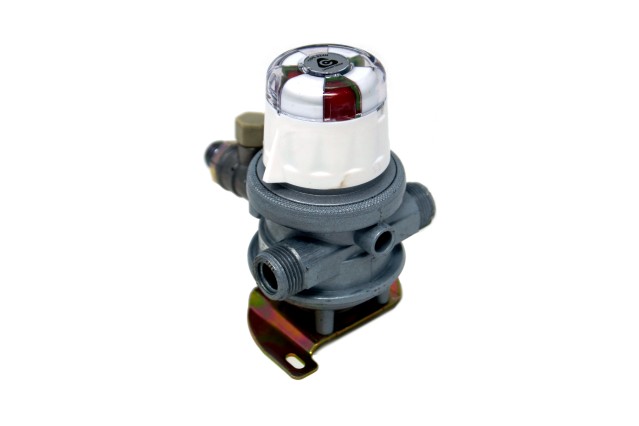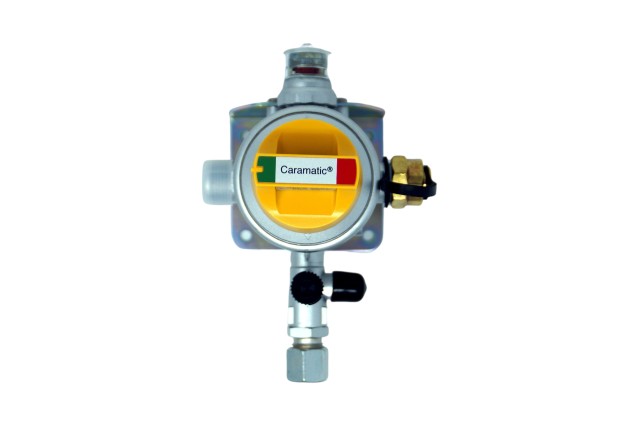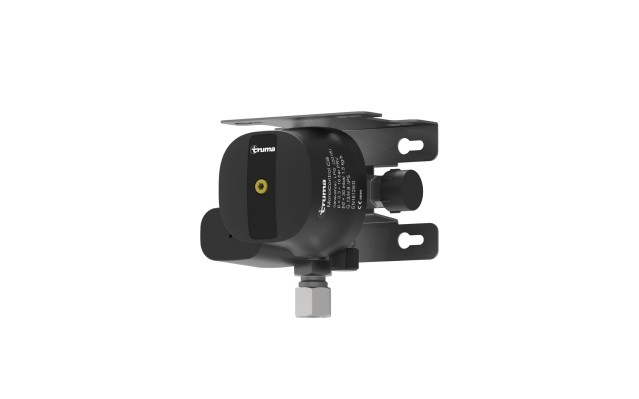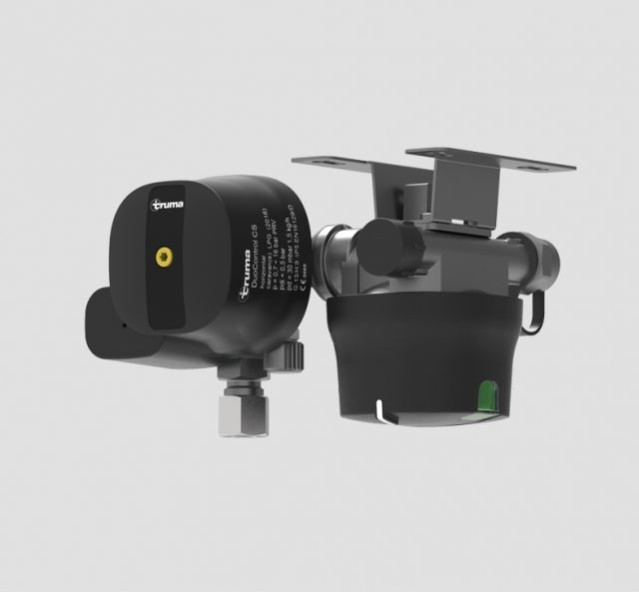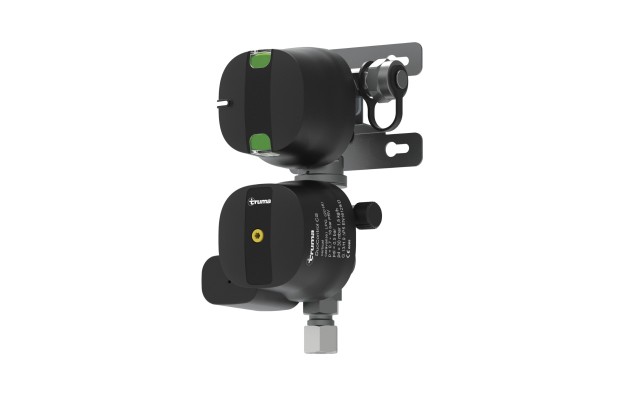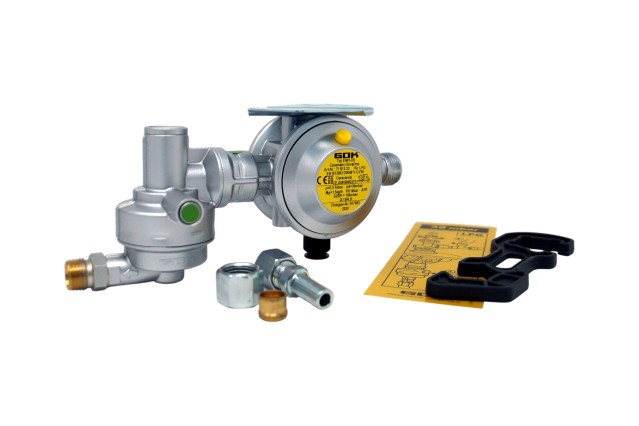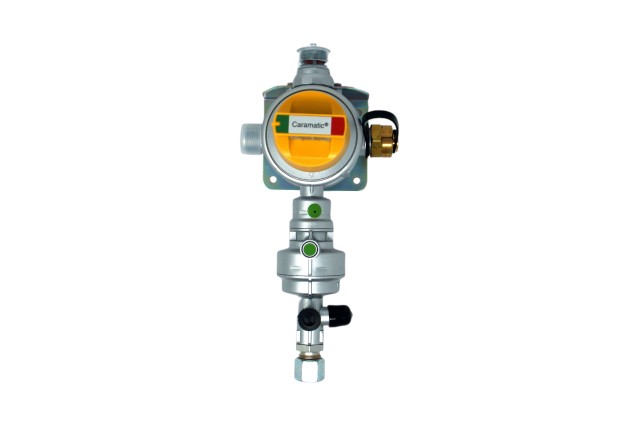Gas regulators are components in LPG conversion kits that are intended to ensure a constant pressure. Here you can find the most important information.
Gas regulator, low pressure regulator, lpg regulator and pressure regulator are just four of many different terms that all mean the same thing. A mechanical component that reduces the unregulated liquid gas pressure from a container to the pressure required by the gas appliance.
Table of contents
What is a gas regulator?Why do you need a gas regulator?
What does a gas regulator do?
How does a gas regulator work?
Where is the gas regulator located?
When do I need a gas regulator?
What gas regulators are there?
According to pressure levels
According to equipment and function
According to area of application
Special versions
Selection criteria
Gas regulators for special applications
Changeover regulator (for two-cylinder systems)
Accessories
Which gas regulator manufacturers are there?
Conclusion
What is a gas regulator?
A gas regulator is responsible for providing the set pressure in bar or millibar.
Why do you need a gas regulator?
Without the use of a gas regulator, liquid gas would flow out of the gas cylinder in an uncontrolled manner at a pressure of between 5 and 10 bar, depending on the ambient temperature.
What does a gas regulator do?
A gas regulator regulates the unregulated liquid gas pressure from gas containers and reduces it to a constant level.
How does a gas regulator work?
The gas enters the gas regulator directly from the gas cylinder or via a high-pressure hose or pipeline. The lpg regulator contains a mechanism that reduces the high inlet pressure to the desired outlet pressure. This mechanism typically consists of:
Diaphragm: A flexible diaphragm that reacts to pressure changes.
Spring: This exerts pressure on the diaphragm to set the desired outlet pressure.
Valve: The valve opens or closes depending on the pressure ratio to regulate the gas flow.
The gas escapes from the gas regulator at the set pressure and is directed to the connected appliance (e.g. gas barbecue, heater).
Where is the gas regulator located?
The installation of a gas regulator depends largely on the type of gas supply and the application. Directly on the valve of the gas cylinder. The regulator is screwed onto the valve of the gas cylinder. For cylinders with quick coupling systems, e.g. for forklift trucks powered by liquid gas, the regulator is snapped into the coupling. Wall mounting in the leisure vehicle. The lpg regulator is connected using a high-pressure gas hose with hose rupture protection or a rigid line (copper or steel). The connection from the lpg regulator to the respective appliances is made using a medium-pressure gas hose or, for installations in vehicles or on boats, via a steel or copper line.
When do I need a gas regulator?
A gas regulator is used without exception when liquid gas is to be used for combustion purposes, e.g. heating, barbecuing, cooking or cooling.
Which gas regulators are available?
There are almost countless types and variations of LPG pressure regulators. These gas regulators differ in terms of function, pressure level, equipment and area of application, among other things.
According to pressure level
- Low pressure regulator (30 mbar /27 mabr/ 50 mbar):
– For the operation of appliances with low operating pressure, such as camping stoves, gas barbecues, radiant heaters or motorhome applications.
– Standard in many European countries:
30 mbar: For new appliances in motorhomes, caravans and boats.
37 mbar: For the French market
50 mbar: Still common in older appliances and regionally. - Medium pressure regulator (0.5 to 4 bar):
– For appliances that require more gas pressure, e.g. in industrial applications or larger radiant heaters.
– Often adjustable in order to be able to set different pressures. - High pressure regulator (over 4 bar):
– For industrial applications, such as cutting torches, welding equipment or large heaters.
– Often equipped with safety devices such as pressure relief valves.
According to equipment and function:
- Simple pressure regulator:
– Without additional functions
– Reduces the pressure from the cylinder to the operating pressure - Pressure regulator with safety shut-off valve (SAV):
– Interrupts the gas flow in the event of a sudden drop in pressure, e.g. due to a hose rupture
– For applications with increased safety requirements - Regulator with pressure relief valve (PRV):
– Allows gas to escape if the pressure becomes too high
– Protects the connected appliance from damage - Changeover regulator:
– For systems with several gas cylinders such as Cavagna Multimatik, GOK ProTwo
– Automatically switches to the reserve cylinder when the main cylinder is empty - Regulator with pressure gauge:
– Displays the pressure to monitor the filling level of the gas cylinder or the function of the regulator - Adjustable pressure regulator:
– The outlet pressure can be set manually
– Useful for appliances with varying pressure requirements - Lpg regulator with crash sensor
– For using gas while driving in a motorhome, camper or caravan
– From GOK (GOK Caramatic, GOK Caramatic SafeDrive), Truma (Truma MonoControl CS, Truma Duo Control CS) or Cavagna Toptron - Lpg regulators for boats
– With a special coating to prevent corrosion.
According to area of application:
Household: For gas barbecues, patio heaters or camping stoves. Compact and easy to install.
Motorhomes and boats: Special regulators that are certified for mobile applications. Often equipped with crash sensors or thermal fuses.
Industry: High-pressure and special regulators for cutting, welding or heating appliances.
Fixed installations: Regulators for central gas supply systems (e.g. LPG tanks for heating systems).
Special versions
Dual pressure regulator: Combines high and low pressure regulation.
Regulator for multi-bottle systems: In commercial areas, e.g. gastronomy.
Regulator with frost protection: For applications in cold environments.
Selection criteria:
Gas type: Propane, butane or mixtures.
Pressure requirement: Operating pressure of the connected appliance.
Safety requirements: Additional safety functions such as SAV, PRV or crash sensor.
Area of application: Mobile, stationary, private or industrial.
Gas regulators for special applications
Gas regulators for vehicles
The questions come up again and again: Which gas regulator for motorhomes? Which gas regulator for caravans?
For recreational vehicles such as motorhomes, caravans and campers, there are special gas regulators that ensure the safe operation of the gas installation. These lpg regulators are designed for mobile applications, such as vibrations and special safety standards. Here are the common types and their features:
Simple low pressure regulators:
Pressure: 30 mbar (standard in Europe and the USA for new vehicles).
Use: For the operation of gas appliances (e.g. heating, refrigerator, stove).
Installation: Directly on the gas cylinder or on the fixed gas pipe.
Gas regulator with crash sensor (CS):
Function: Interrupts the gas flow in the event of a severe impact (e.g. in the event of an accident).
Regulation: Required according to DIN EN 1949 if gas appliances are operated while driving (e.g. heating).
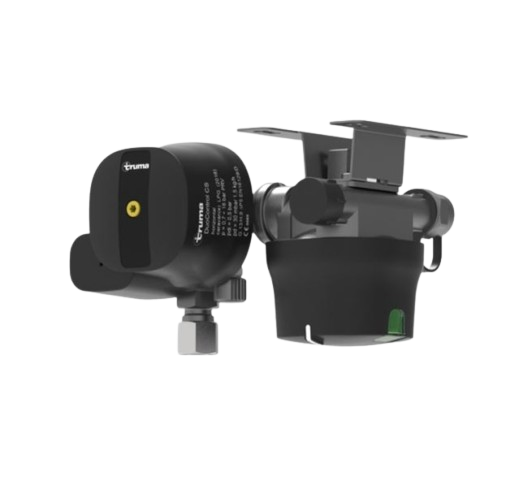
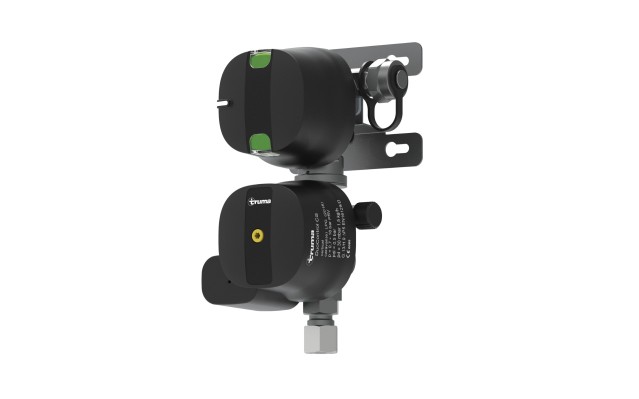
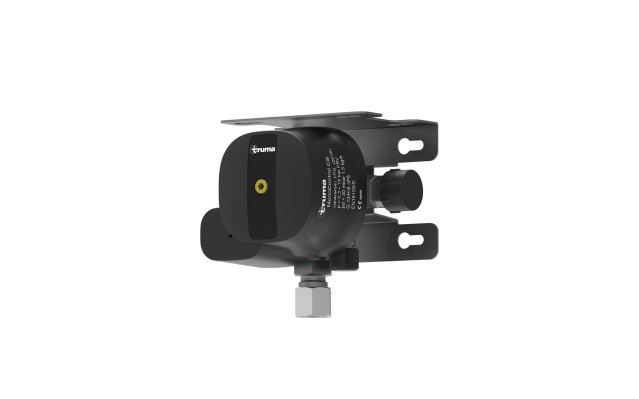
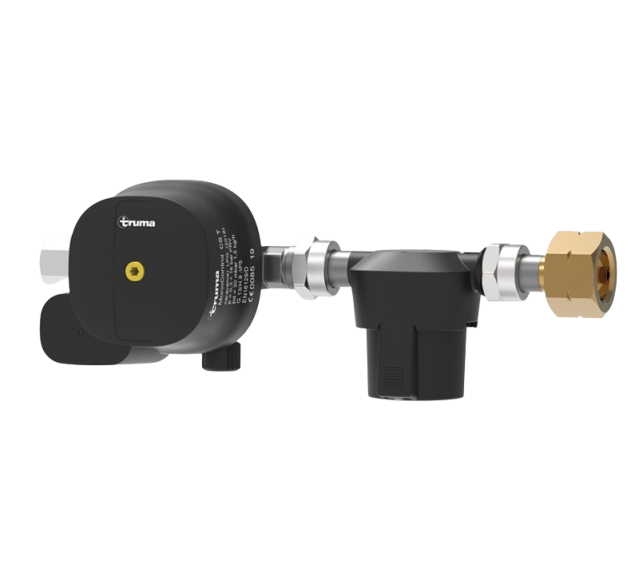
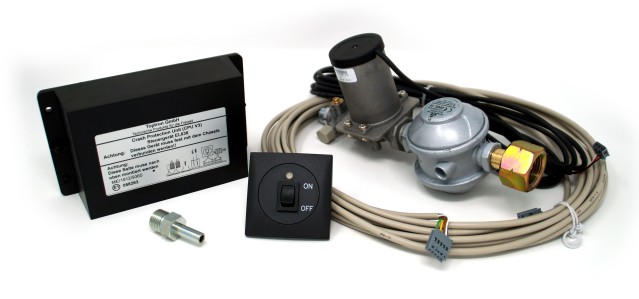
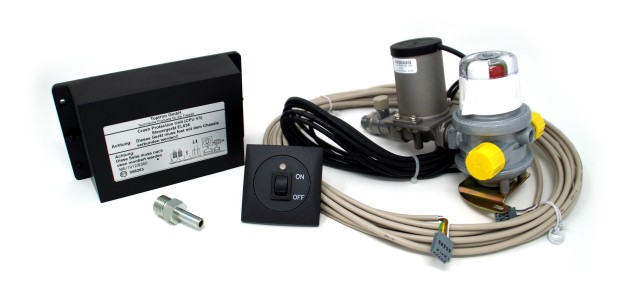
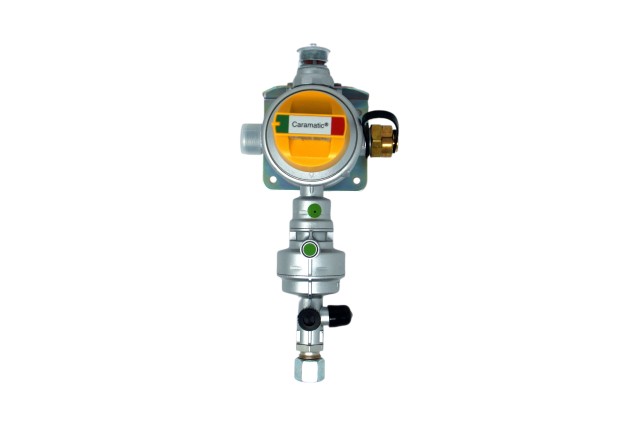
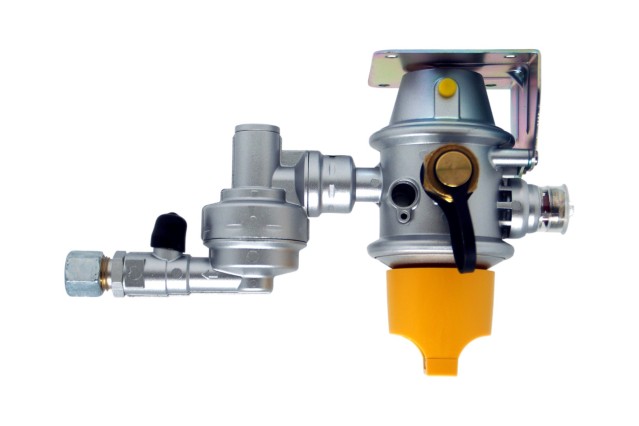
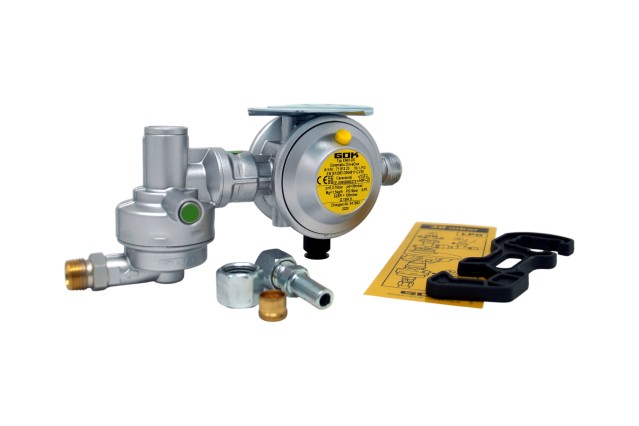
Changeover regulator (for two-bottle systems):
Function: Switches automatically from the empty main cylinder to the reserve cylinder.
Automatic changeover switches: Switch automatically and display the status of the cylinders.
ATTENTION: These gas regulators do not have a crash sensor, so gas withdrawal while driving is not permitted.
Regulations and standards:
DIN EN 1949: Regulates the safety of LPG conversion kits in leisure vehicles. Crash sensors are mandatory if devices are running while driving.
Inspection: The LPG conversion kit must be inspected regularly, e.g. every 2 years in Germany (G 607 inspection).
Gas regulator for refillable gas bottles
There are no special gas regulators for refillable gas bottles. The GOK SafeDrive system is recommended if you want to do without wall mounting but still want to heat while driving. Otherwise, depending on whether a 1 or 2 cylinder system is installed, a Truma Mono Control or Truma DuoControl CS can be fitted.
Gas regulator for gas cylinders
Very different gas regulators can be used for gas cylinders. Depending on the area of application, GOK offers lpg regulators with a safety or pressure relief valve. Here you will find an overview of all available lpg regulators for gas cylinders.
Gas regulators for marine applications
For the marine sector (e.g. boats, yachts, sailing ships), there are specially designed gas regulators that meet the special conditions on the water. These regulators are robust, corrosion-resistant and meet strict safety requirements, as the operation of LPG conversion kits in maritime environments is potentially more dangerous.
Special requirements for lpg regulators for boats
Corrosion resistance: Protection against salt water and humid environments through stainless materials (e.g. stainless steel or special coatings).
Safety devices: Additional mechanisms such as thermal fuses, pressure relief valves.
Compact design: Space-saving to make optimum use of tight spaces on boats.
Shake and vibration resistant: For use on moving platforms.
Certifications: Must be approved according to national or international regulations such as ISO 10239 (installation and maintenance of LPG systems on boats).
LPG conversion kits on boats are tested in Germany by G 608 experts.
Gas regulators for commercial use
Commercial applications require special gas regulators that meet the high requirements for safety, performance and service life. Depending on the area of application and appliances, there are different types of commercial lpg regulators. The leading manufacturer of commercial lpg regulators is GOK. Cavagna also offers solutions for commercial gas use.
Requirements for commercial lpg regulators
Higher load capacity: Regulators must continuously supply large quantities of gas safely and stably.
Robust design: For continuous use in demanding environments.
Compliance with legal regulations: Regulations such as TRF (Technical Rules for Liquefied Petroleum Gas) or the German Ordinance on Industrial Safety and Health (BetrSichV) must be complied with.
Additional safety features: E.g. pressure relief valves, thermal fuses, and hose rupture safety devices.
Types of commercial lpg regulators
a) Low pressure regulator (30 or 50 mbar):
Use: Standard for appliances such as barbecues, radiant heaters, deep fryers or gas cooking appliances.
Examples: Gastronomy, market stalls, food trucks.
Types: With or without safety devices.
b) High pressure regulator (0.5 to 4 bar or higher):
Use: For appliances with high pressure requirements, e.g. gas burners, welding and cutting equipment.
Adjustable: Allows the outlet pressure to be adjusted.
Examples: Metalworking, construction, industrial heating.
c) Multi-cylinder systems (changeover regulator):
Function: Automatic switching between several gas cylinders when one is empty.
Use: Catering, commercial kitchens or other commercial applications with continuous gas demand.
d) Special regulator for high outputs:
Use: Commercial hot air appliances, radiators, large heating appliances or special ovens.
Pressure range: Often individually adjustable. Safety functions for commercial lpg regulators
Pressure relief valve (PRV): Releases gas if the pressure becomes too high.
Thermal shut-off device (TAE): Closes the gas flow at extremely high temperatures.
Hose rupture safety device (SBS): Stops the gas flow if the hose is defective or torn off.
Pressure gauge: Monitors the gas pressure to prevent malfunctions.
Regulations for commercial LPG conversion kits in Germany
In Germany, the TRF (Technical Rules for Liquefied Petroleum Gas) regulate the requirements for the installation and operation of liquefied petroleum gas systems. The Ordinance on Industrial Safety and Health (BetrSichV) describes the regulations for the safe handling of pressure regulators in commercial systems.
Regular inspection:
Commercial systems must be checked regularly for leaks and function.
Accessories
We carry a large selection of gas regulator accessories: hoses, adapters, seals and valves.
Which gas regulator manufacturers are there?
There are numerous manufacturers of gas regulators offering products for various applications, including household, commercial, industrial, leisure and specialty applications such as marine or camping. Here is an overview of the best-known manufacturers:
GOK
Based in: Germany.
Main focus:
Liquid gas pressure regulators for household, camping, trade and industry
Safety accessories such as hose rupture safety devices and pressure relief valves
Regulators for stationary and mobile applications (e.g. motorhomes)
Well-known products:
Caramatic series: For leisure vehicles and commercial use
Professional high-pressure regulator: For industrial applications
Special feature: Made in Germany, high quality, compliance with all relevant standards

Cavagna Group
Headquarters: Italy
Main focus:
Regulators for liquefied petroleum gas (propane/butane) and natural gas
High and low pressure regulators for domestic, commercial and industrial applications
Complete solutions for gas supply systems
Well-known products:
High-pressure regulators for welding and cutting applications
Regulators for multi-cylinder systems
Special feature: International presence, large product range

Truma
Headquarters: Germany
Main focus:
Gas regulators for recreational vehicles
Regulators with crash sensors and safety functions
Regulators for operation while driving
Well-known products:
MonoControl CS: For single cylinder systems
DuoControl CS: Automatic changeover regulator for multi-bottle systems
Special feature: Leader in the field of mobile gas supply
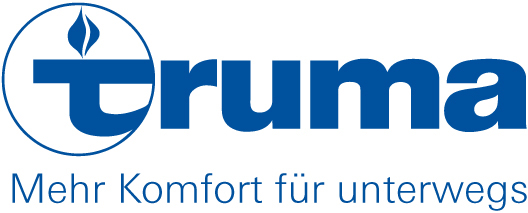
SRG Rotarex
Headquarters: Luxembourg
Main focus: Gas regulators with clip-on valve technology
Well-known products:
Jumbo Clip-On gas regulators
Special feature: The invention of the Jumbo Clip-On quick-connect system and its patenting in 1934 laid the foundation for the founding of SRG

IGT
Headquarters: Denmark
Main focus: Lpg regulators for domestic, leisure and boats
Well-known products: Clip-on regulators, screw-on regulators for gas cylinders
Special feature: Broad product portfolio, global coverage of all connections

Conclusion:
Answering the question „Which gas regulator do I need“ depends entirely on the area of application. We have presented a few. If you still have any questions, please contact us.


